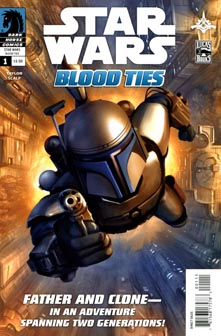George Lucas’ revelation in 2002’s “Attack of the Clones” that Boba Fett was the clone son of Jango Fett opened up a new vein of Fett stories. While subsequent stories would retain some of the pre-2002 “mysterious loner” aspect, the revelation about his background encouraged writers to explore the bounty hunter’s rare personal bonds as well.
The trend actually started before “Attack of the Clones,” with Beau Smith’s 2001 comic short story “Outbid But Never Outgunned” in “Tales” Issue 7. Smith revealed that a teenage Boba Fett had a love interest, fellow bounty hunter Sintas Vel. Although the “Tales” stories were not necessarily canonical within the EU, this one became canon when Karen Traviss revealed in her “Legacy of the Force” books (2006-08) that Sintas and Boba were briefly married and that the kid in the hologram at the end of “Outbid” was their daughter, Ailyn.
Traviss’ “LOTF” books further revealed that Ailyn had a daughter, Mirta Gev. Then Ailyn is killed by Darth Caedus, and Sintas is found to have been frozen in carbonite; she is then thawed out and reunites with Fett and Mirta. Whew. Although Mirta becomes a well-developed character in “LOTF” – particularly after she drops her desire to kill her grandfather and instead gets to know him — Sintas and Ailyn were defined by their relationship to Fett. We know them by what they mean to Fett: He regrets abandoning Sintas and never knowing his daughter.
Also in Traviss’ books, Fett spends a fair amount of time thinking about his late father, Jango. We did see some Jango-Boba family moments in “Episode II,” and we got Jango’s backstory in “Jango Fett: Open Seasons.” But although we know from his inner monologues how much these people mean to Boba Fett, we had seen very little of Boba’s backstory co-starring Jango, Sintas and Ailyn.
Two four-issue “Blood Ties” comic series from Dark Horse — “A Tale of Jango and Boba Fett” (2010) and “Boba Fett is Dead” (2012) – changed that. The former starts with Jango training Boba using tough love, throwing his son into a live-or-die situation with a vicious monster; the idea is that if he survives, he’ll never have to face something that scary again. Then the action moves forward to Boba’s bounty-hunting prime – a time when he knows Sintas.
Even these stories keep their emotional distance. There’s plenty of Boba Fett action in them, so it’s not exactly false advertising, but the main character of “Blood Ties” is actually Connor Freeman, the son of a clone trooper defector — so Freeman and Boba Fett are essentially cousins. (As the son of a clone defector, Connor shares a similar backstory to Venku from Traviss’ “Republic Commando” and “LOTF” books. But although Connor has a knack with a blaster and for being able to fall asleep on a barstool, he doesn’t have Force abilities.)
Boba Fett develops a bond with Freeman after he finds out that Jango had set up an inheritance for the boy; Jango felt remorse for killing Connor’s dad as part of an assassination assignment from Count Dooku. In both “Blood Ties” comics, Boba and Connor end up on the same side. Despite this, writer Tom Taylor (accompanied by painted panels from Chris Scalf) is careful not to give us a kinder, gentler Boba Fett. These yarns are still very much in the style of the previous “Boba Fett” comics, many of which were penned by John Wagner.

For example, at the end of “Jango and Boba Fett,” Boba presents Connor to a crime lord to collect his bounty. But he then accepts Connor’s bounty of three credits on the crime lord, and kills the crime lord. He also doesn’t let Connor skate on those three credits: “Boba Fett always collects,” he tells him, thus reminding the reader of the strict business code – and the associated pitch-black humor — established in previous comics such as Ron Marz’s “Wreckage” (“Empire” Issue 28). “Jango and Boba Fett” shows that Boba learned this way of doing business from his father. Rather than entering into landing-fee negotiations on Atzerri, Jango simply blows the sentry ship out of the sky with a pair of missiles from the Slave I.
And in “Boba Fett is Dead,” Fett unleashes an angry dewback on a stormtrooper who had been abusing the creature. Fett doesn’t technically kill the stormtrooper, he just lets nature take its course (he dispatches a sniveling collectibles dealer in similar fashion in “Outbid”). Later, Fett hires away a henchwoman of a man he is targeting: “You work for me. You will be paid. But cross me – or try to run – and I will find you.” The fact that we see Fett’s face (the likeness of Daniel Logan) makes these comics different from the pre-“Episode II” comics, but Fett’s behavior is the same as ever.
“Boba Fett is Dead” takes place after “Outbid But Never Outgunned,” so for continuity reasons Fett can’t actually meet up with Sintas, but Taylor uses Connor as a bridge. Connor teams up with Sintas – and the resourceful little Ailyn, who has already been trained by her mom in the survival arts – as Sintas is being pursued by the father of a man who was killed by her husband. As we found out in “LOTF,” Fett killed the man because he had raped Sintas, but he never presented this as a motive, and was thus convicted of murder, necessitating Fett to flee Concord Dawn.
From a distance, Fett helps protect Sintas again, but this is the last time he’ll see her for a half century. As a bonus, we now know that one of the post-Boba relationships Sintas mentions in “LOTF: Revelation” is Connor – and we know that Boba also knew this even before he asked.
While there are still a lot of incidents alluded to in “LOTF” that go untold – for example, how did Sintas come to be carbon-frozen about a decade after the events of these comics? – the fact that we get a comic story featuring Sintas significantly helps Traviss’ Fett backstory come alive.
The title “Boba Fett is Dead” is evocative of a lot of Fett stories throughout the timeline – most famously, he was thought by some to have been eaten by the Sarlacc; “Dark Empire” first informed readers this was not the case. (In an example of how silly Disney’s reboot of the “Star Wars” canon is, the mystery of Fett’s fate after the Sarlacc is now being repeated. As of now, for people who care, Fett is neither dead nor alive in the Disney canon.)
It’s not much of a spoiler to reveal that the supposed dead Boba Fett on the cover of “Boba Fett is Dead” Issue 1 is not actually Fett. It’s just some poor bounty (who doesn’t even get a name) whom Fett put in his armor in order to take a barrage of bullets for him while Fett escaped. In a lucky break, the enemies shoot the man in the face, so he can’t be identified as not being Boba Fett.
People being mistaken for Fett is another common trope in the EU. In “The Search Begins” (Marvel Issue 68), Leia believes she has encountered Fett, but it’s actually Fenn Shysa. This was readers’ (and Leia’s) first hint that characters other than Fett wore Mandalorian armor. In “Twin Engines of Destruction,” a comic in “Star Wars Galaxy Magazine,” Fett tracks down and kills Jodo Kast, who had been passing himself off as the legendary bounty hunter. Fett seemingly appears in the “Young Jedi Knights” books, but this was later retconned to be his daughter, Ailyn. Finally, a Mandalorian named Spar is mistaken by Ailyn as being Boba Fett, and she kills him, as recounted in the “LOTF” books. And I’ve probably forgotten a few other examples.
While Boba Fett is a rich character who invites essays about his loner lifestyle and strict moral codes, the handful of characters who play a role throughout his life span (Jango, Sintas, Ailyn, Mirta and now Connor) haven’t been explored as much. The “Blood Ties” comics take a step toward changing that, and that makes them worth a read, in addition to the fact that they work as traditional dark-humor-laden Boba Fett bounty hunting yarns.

